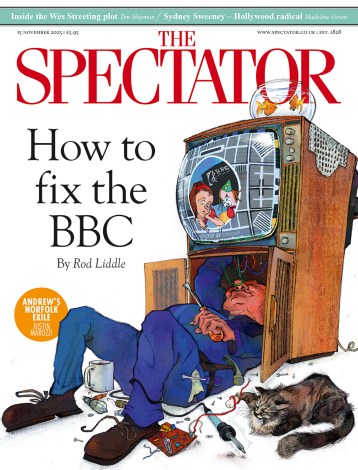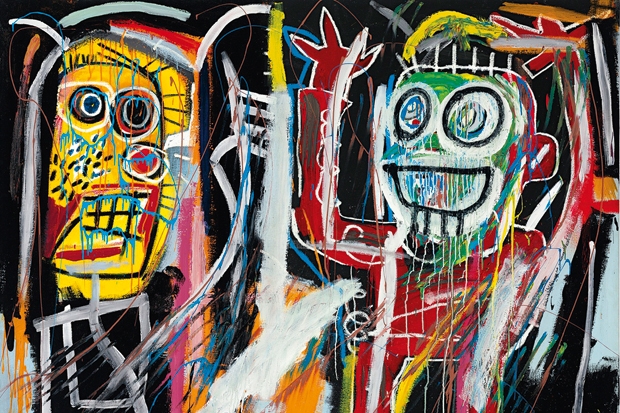Earlier this year a painting by Jean-Michel Basquiat, depicting two figures stoned on the hallucinogenic drug PCP, was offered for sale at Christie’s in New York. ‘Dustheads’ was given an estimated sales tag of $25–35 million. In the end, the hammer came down at $48.8 million, a sum that easily broke the previous record for the artist, $26.4 million, which was achieved last November. It was the fourth time in 12 months that Basquiat’s record price had been smashed, and confirmed the artist’s dominance of the contemporary market.
Such record-breaking at auction tends to elicit valedictory statements from auction houses and Christie’s Loic Gouzer duly obliged: ‘“Dustheads” is pure, concentrated energy, freedom and honesty.’ But it is what Gouzer went on to say that is of more interest: ‘Ten years ago [Basquiat] might have been perceived as a misfit. Today, he is the most collected artist of sportsmen, actors, musicians and entrepreneurs.’
This statement, with its defensive undercurrent, attests to a gulf between what the market now makes of Basquiat and how art critics and historians have, at least until relatively recently, rated him. Basquiat’s career was short-lived and dramatic. He emerged as part of a graffiti collective called SAMO spraying buildings in Lower Manhattan in the late 1970s. Then, in quick succession, he formed a band (which included Vincent Gallo), appeared on Glenn O’Brien’s television programme TV Party, starred in an indie film, popped up in Blondie’s video for ‘Rapture’, and met and hung out with Andy Warhol. He also decided to move his artwork from the streets to the gallery and, from his debut solo exhibition at Annina Nosei’s gallery in 1981, he enjoyed a meteoric rise that saw its apotheosis in his appearance on the cover of the New York Times Magazine in early 1985. Basquiat exhibited with some of the most eminent art dealers in the world, including Bruno Bischofberger, Mary Boone and Larry Gagosian, producing paintings at a tremendous rate, fuelled by a gargantuan appetite for drugs. True to the cliché of burning bright and short, Basquiat died aged 27, three years after the cover shoot, of a heroin overdose.
Despite his fame, Basquiat was dismissed by a number of art critics and historians. The Oxford Dictionary of Art and Artists labelled him a ‘street artist’ and included him under the entry for ‘Graffiti’ rather than giving him his own named entry. The art critic Robert Hughes described his work as ‘merely novel’. But arguably his biggest adversary was the eminent American critic Hilton Kramer, whose descriptions of his work included the posthumous appraisal: ‘talentless hustler, street-smart but otherwise invincibly ignorant, who used his youth, his looks, his skin colour and his abundant sex appeal to win an overnight fame that proved to be his undoing’.
In fact, it was not Basquiat’s overnight fame that was his critical undoing, but a style of painting which, in its insistence on an expressionist style and the figurative, was rejected as regressive by art historians. And it is here that the critical mauling of Basquiat has parallels with that of a painter of the previous generation whose reputation has been revalidated by the market — Francis Bacon. The record for Bacon’s work ($86.2 million) was achieved in 2008 and, despite a recent blip, the artist has been one of the most consistently high-achieving modern artists at auction in recent years. (A number of observers expect a huge price for his 1969 painting ‘Three Studies of Lucian Freud’ to be auctioned by Christie’s in New York this week, although the auction house’s first autumn sale there last week was decidedly sluggish.) Yet the Guardian’s art critic, Jonathan Jones, was able to open a 2007 article on Bacon with the question, ‘Is Francis Bacon a great 20th-century artist or not?’, before going on to argue that he ‘was the first modern artist to abandon modernism’. Jones was referring to the fact that Bacon rejected the key tenet of modernism: abstraction. In the eyes of art history, the story of the avant-garde is a move from the figurative to the abstract, and Bacon’s reliance on the figurative, like Basquiat’s after him, was seen as an abandonment of the prescribed path of the avant-garde.
Bacon’s choice of sitters — friends and lovers who were drunks and wastrels of Soho — also flew in the face of modernist art history’s disavowal of the personal. Basquiat’s insistence on personal subject matter was equally suspect. For this marked out each artist as a neo-expressionist, reviving the idea of the artist as a tortured genius pouring out visions that are heightened but recognisable depictions of the world around them. These are paintings that prize a highly individual vision and, for the majority of art historians, this was unspeakably regressive. Notions of individual expression were the enemy of modernist and postmodernist art history, a discipline that was heavily influenced by critical theory, a hodge-podge of writings that ranged from the unreadable (French post-structuralist theory) to the poetically barmy (post-Freudian psychoanalytical theory), much of which removed agency from the individual and placed it instead with societal or psychological structures.
Expressionism received a comprehensive debunking at the hands of the influential academic Hal Foster in his 1983 essay ‘The Expressive Fallacy’, a work that became required reading in art historical departments over the next 20 years. In the widely cited article, Foster argued that, even if artists were able to experience a truly subjective emotion, the act of trying to recreate that emotion on canvas was necessarily fake. By the time the artist had got the paints out and made the necessary marks, any raw emotion would be a distant memory. At best, the paint-marks would be a half-remembered account of an emotional experience. At worst, the entire depicted emotional experience would simply be fiction. Foster preferred and recommended postmodern artists such as Cindy Sherman, whose work was all about the constructed nature of supposedly real experiences. This contrasted starkly with Bacon, and his booze-addled subjects, and Basquiat, with his druggie drop-out persona and subject matter, who would rank pretty high up in the faked emotion scale.
But the subsequent 21st-century market dominance of Bacon and Basquiat suggests that art history’s pronouncements are marginal to the main business of selling and buying art, no more relevant than the embittered outpourings of Marxists and ex-Marxists who desperately wished art would point to social progress rather than simply being a series of pleasant things to look at. And while this might sound like an overly simplistic reading of the situation, there is significant evidence of the growing influence of taste-makers who really don’t care about art history’s judgments — collectors.
Basquiat’s biggest collector, Jose Mugrabi, strolled out of February’s auctions with the simple statement: ‘Basquiat is the best artist in the world.’ His son Alberto has a Basquiat-style crown motif tattooed on his wrist. The Mugrabis, like those who collect Bacon, seem to value nothing more than a highly individualistic, expressive view of the world. And auction houses seem ready to make the break from those fusty old Marxist art historians and instead follow the lead of the prescient remark, made by Sotheby’s Tobias Meyer in 2006, ‘The best art is the most expensive because the market is so smart.’ The market, fuelled by the money of ‘sportsmen, actors, musicians and entrepreneurs’ (as well as that of oligarchs, sheikhs and hedge-funders), might not be as smart as Meyer suggests, but it is certainly determinedly revalidating the value of highly individual visions, whether fuelled by hallucinogens or not.






Comments